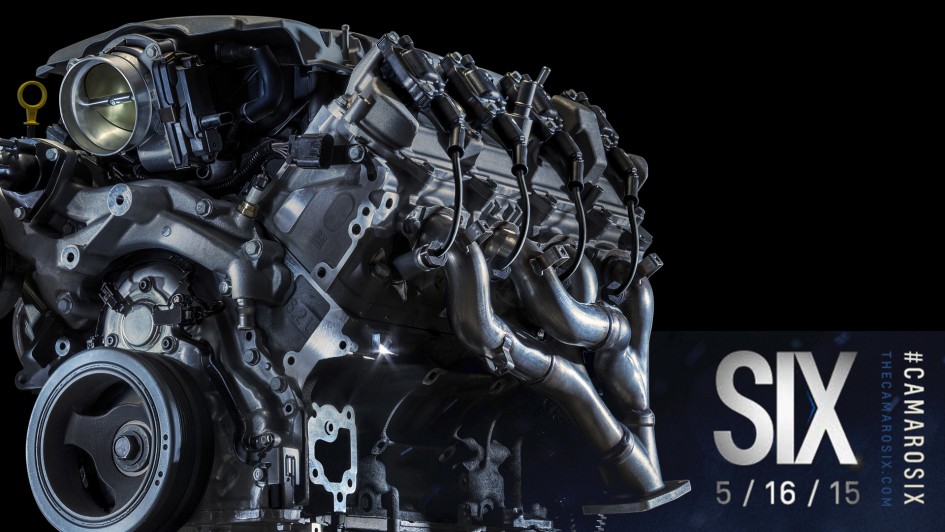Partager la publication "Chevrolet présente la Camaro on Saturday, May 16 à Detroit #CAMAROSIX MAJ 16/05 : 23h"
The Sixth-Generation Chevrolet Camaro sera présenté le 16 mai, aux medias et au public, lors d’un event live à Detroit ! En attendant, Chevy tease de superbes images mécaniques automobile de sa prochaine Camaro ! Profitons-en pour découvrir les générations Camaro de 1966 à 2014 (genre dossier avec du texte sur les moteurs small-blocks / big-blocks, et des infographies sur le design de chaque génération de Camaro), puis enfin profitons des visuels en haute qualité de la 2016 Camaro ! Et du son du moteur, comme le dit Chevy : ‘The Silence Is Broken‘. MAJ 16/05/2015 : 23h20 (France)
The Camaro SIX Premiere, 5/16/15
We couldn’t be prouder to say Camaro has some of the fastest, most loyal fans in the industry. THE CAMARO SIX PREMIERE event reached full capacity in just over 8 hours after its announcement. It is still set for 5/16/15 on Belle Isle in Detroit.
Here the site dédié à l’event: thecamarosix.com
cinq générations de Chevrolet Camaro
La Chevrolet Camaro est une automobile de type pony car construite par General Motors de 1967 à 2002 en quatre générations et dont la production a repris en une cinquième en 2009. La Camaro fut construite pour concurrencer la Ford Mustang.
The first Camaro
Lorsque Ford présente sa Mustang en avril 1964, l’état major de GM ne se montre pas vraiment impressionné, persuadé qu’il n’existe pas de marché pour ce type de véhicule et qu’avec son « petit » coupé le rival de toujours foncerait vers de sinistres destinées. Leurs espoirs seront de courte durée ; quatre mois seulement après son lancement, 100 000 Mustang sont sorties des chaînes de fabrication. L’ambiance au directoire de General Motors se dégradera considérablement. Il leur faut faire mieux, et vite, pour retrouver leur première place sur le marché national. Dans l’urgence, Chevrolet crée le projet XP836 surnommé « Panther ». Ses lignes très pures, exemptes de toute fioritures, combinent harmonieusement volumes et rondeurs avec des éléments plus anguleux.
À sa sortie, Chevrolet précise que le nom du nouveau modèle vient d’un mot français, « camaro », signifiant « camarade » en argot mais Ford rétorque ironiquement que c’est le nom d’un type de crevette (« Camarón » veut dire « crevette » en espagnol). Chevrolet dira alors sur le même ton qu’un Camaro était « un petit animal méchant mangeur de Mustang ».
1966 Camaro
La Camaro de série voit le jour le 26 septembre 1966, sur le tout nouveau châssis F-Body qui se caractérise par un format quatre places, disponible en coupé et en cabriolet, et d’une architecture faux châssis à l’avant fixé sur une coque. Ce châssis était basé principalement sur celui d’une autre Chevrolet sortie plus tôt, la Nova (1962 – 1979).
La Camaro partage beaucoup de pièces mécaniques avec la Chevrolet Nova dont la conception est en partie issue. Le F-Body est le châssis General Motors utilisé sur les Chevrolet Camaro et Pontiac Firebird. Il y en a quatre types, les deux premiers (1967-69 et 1970-81) sont similaires en architecture, avec un faux châssis à l’avant fixé sur une coque.
De nombreux moteurs sont disponibles dès cette première année, du six cylindres en ligne de base au puissant V8 de 396 ci de la Camaro SS396. La Camaro en version SS est équipée du V8 small block de 350 ci ou du V8 big block de 396 ci.
À noter que les Camaro ne portent réellement le qualificatif de muscle car qu’à partir du modèle « 396 », tous les modèles ne possédant « qu’un » small block, de cylindrée inférieure, sont appelés pony cars.
The design of 1967 Camaro
Vice president of GM Global Design Ed Welburn owns a 1969 Camaro so he knows a thing or two about the first-generation model.
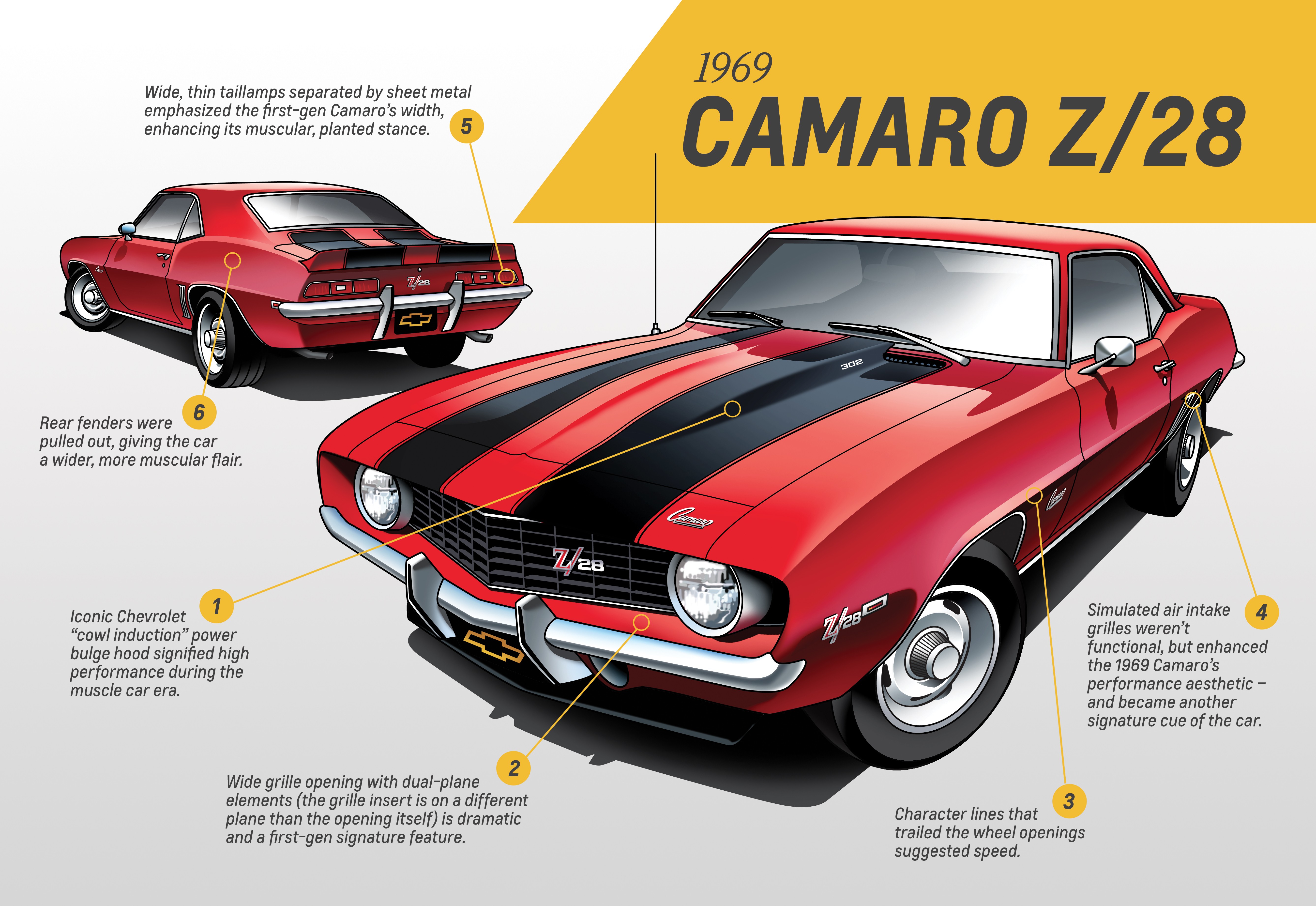
Camaro – First Generation – 1967-69 – Ed Welburn, vice president of GM Global Design
‘The Camaro should not have been a design success, as it was based on an existing architecture and admittedly hurried to market to address the personal coupe revolution occurring with Baby Boomer customers.’
‘However, the first-generation Camaro delivered a pure, classic proportion that will forever be regarded as one of the best-looking cars of its time. It was very lean and muscular, with comparatively minor embellishments for high-performance models.”
‘The 1969 model is the iconic Camaro to me. From the dual-plane grille design and speed lines stamped into the fenders and doors, it was original and distinctive. It didn’t borrow from any other design and all these years later, it still looks fresh.’
- Ed Welburn, Vice president of GM Global Design
Bonus sur le Web with CamaroNews!
http://www.camaronews.com/camaro-videos/the-first-camaro1967-hardtop-to-be-at-belle-isle/
The First Camaro 1967 Hardtop, To Be At Belle Isle CamaroSix Event
CamaroNews – We were the first ones to do this story a few months back, it hit the internet like a wild storm and from there every other news site ran this story. Well today from Fox News seems to be stating that the 1st ever Camaro built will be at the May 16th event in Detroit. It’s stated, The first Camaro’s next outing will be May 16th when it takes part in the unveiling of the all-new 2016 Camaro in Detroit. The car also will be featured June 26-28 at the GM Nationals in Carlisle, Pennsylvania. This was awesome story and CamaroNews was glad to break it out for everyone. This will be very cool to see at the #CamaroSix event. Until then enjoy the video and a few pics of the car until we see it at the Camaro Six unveil!
CamaroNews featuring ClassicCars.com foxsports.com PilotCarRegistry
The second Camaro
La seconde génération entre sur le marché le 26 février 1970 et sera produit jusqu’en 1981. La carrosserie est intégralement changée, la voiture est alors plus longue et plus large que la génération précédente (de 4,77 à 5 mètres de long suivant les évolutions) avec des lignes plus élancées. L’architecture de 1967 empruntée à la Chevrolet Nova reste cependant inchangée, avec le faux châssis à l’avant séparé de la coque.
Sans la hâte du développement de la première génération et bénéficiant d’un budget supérieur, les ingénieurs de chez General Motors ont pu accorder plus de soin dans la réalisation de la nouvelle Camaro. Ainsi, les suspensions et le châssis sont grandement améliorés aussi bien en ce qui concerne le confort que la rigidité.
Les moteurs de même seront conservés, du moins pour les premières années, toujours équipée de moteurs big block. Cependant, le premier choc pétrolier mettra un terme à la course à la cylindrée. La Camaro restera une des seules muscle car de cette époque à survivre à la crise.
histoire de moteur – small-block / big-block
Un big-block (« gros bloc-moteur ») est généralement un moteur V8 de grosse cylindrée fabriqué en Amérique du Nord. Ce type de moteur est utilisé en automobile mais est aussi monté dans des pick-up, camions ou des bateaux dans ses versions « marine ».
La distinction entre « petit bloc » (small-block) et « gros bloc » (big-block) provient d’une période de l’industrie automobile américaine pendant laquelle chacun des trois grands constructeurs (Big Three), General Motors, Ford et Chrysler, disposait de deux familles de moteurs V8, différenciés par la longueur de leur bloc, chaque taille pouvant recevoir plusieurs cylindrées.
La plus petite cylindrée d’un big-block est d’environ 6 litres, celle-ci est généralement exprimée en cubic inches (ou ci, en français « pouces-cubes »), unité de mesure anglo-saxonne utilisée notamment aux États-Unis. Par exemple un moteur de 429 ci fait exactement 7 030 cm³ de cylindrée, soit 7 litres. Cependant, des moteurs basés sur un bloc court peuvent dépasser cette cylindrée, c’est par exemple le cas actuellement de la Chevrolet Corvette Z06, qui reçoit un small-block de 7 litres.
The design of 1970-81 Camaro
Ken Parkinson, executive director of design, Chevrolet Trucks and Global Architecture, may own a 1968 Camaro but it’s the second-gen car that impressed him the most design-wise.
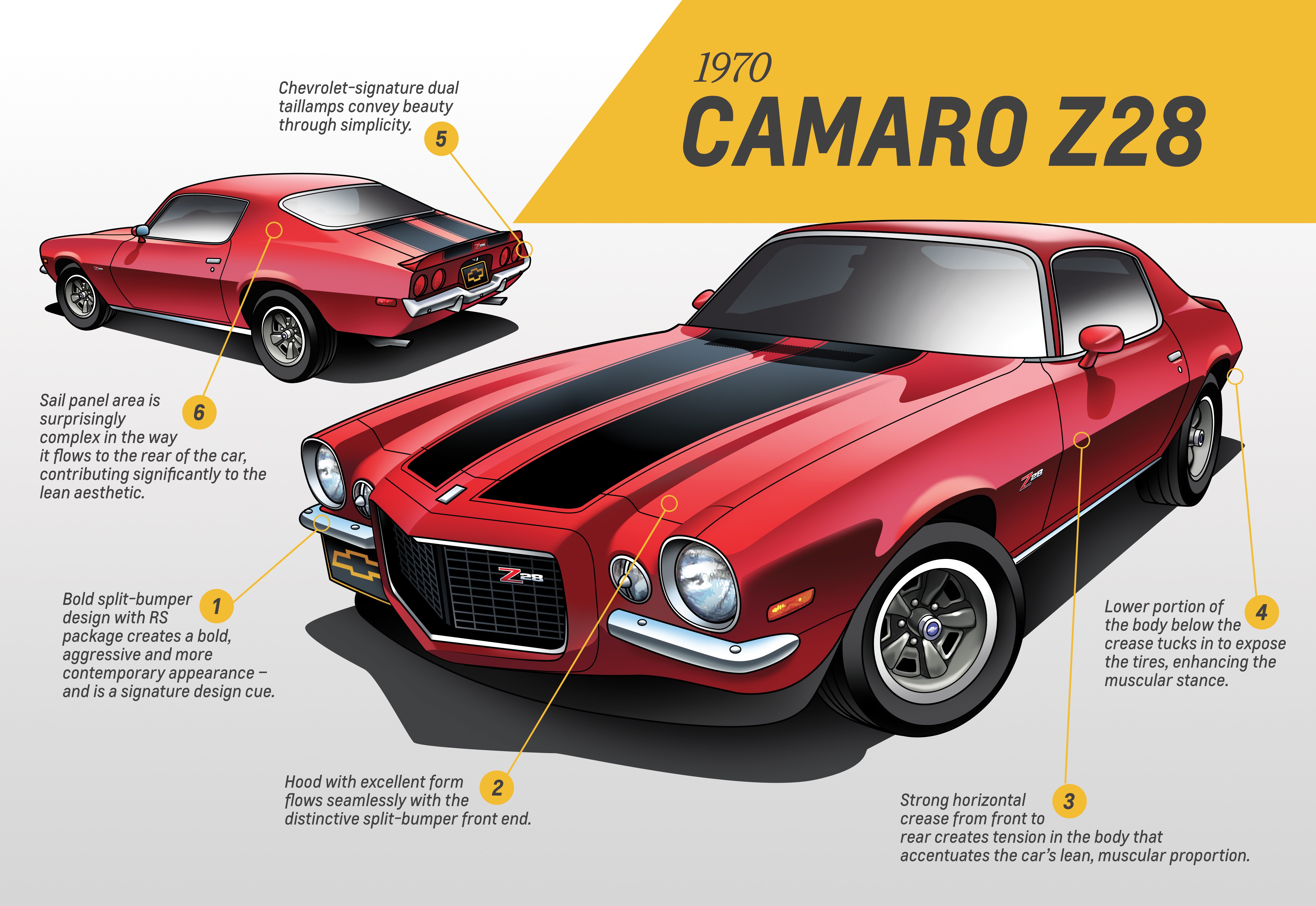
Camaro – Second Generation – 1970-81 – Design analysis: Ken Parkinson, executive director of design, Chevrolet Trucks and Global Architecture
‘It was a radical departure from the first-gen. For the first time, it was built on its own dedicated architecture, which gave the design team the freedom to create a pure expression. What that team created was a powerful expression of American muscle, influenced by a European grand-touring aesthetic. There was simply nothing else like it.’
‘The second-gen car is pure Camaro, with a dramatic proportion and lean, muscular form. You won’t confuse it with the first generation, but it is unmistakably a Camaro from every angle.’
- Ken Parkinson, executive director of design, Chevrolet Trucks and Global Architecture
During its 12 model years, the design of the second-generation Camaro evolved, including the change to soft, body-color fascias and a wraparound rear window.
The third Camaro
En 1975, Chevrolet entreprend le développement de la troisième génération, originellement prévue pour 1980. En même temps, le constructeur travaille sur sa première automobile à traction. Les ingénieurs ont l’intention d’utiliser les composantes mécaniques sur les F-Body. La question de la Camaro à traction a été longuement débattue et retardera la production qui sera reporté à 1982. En outre, les dimensions du moteur de la 3ème génération utilisent le système métrique. La cylindrée n’est donc plus définie en pouces cubes, mais en litres.
L’année 1982 marque donc le début de la troisième génération. Elle est sélectionnée comme ‘pace car’* pour les Indy 500. (ou ‘safety car’ en anglais, ‘pace car’ en Amérique du Nord, comme le précise Wikipedia)
Pour cette occasion la ‘pace car’ voit sa puissance augmentée à 254 ch. Des répliques moins puissantes seront proposées au public. La motorisation passe du 4 cylindre 2,5 litres de 91 ch et d’un V6 de 2,8 litres de 103 ch, à un V8 de (5,0 litres) (305 ci LG4) de 147 ch ou un 5,0 litres ‘Trottle Body Injection’ (TBI) LU5 de 167 ch.
1992 marque la fin de la troisième génération. Tous les modèles 1992 reçoivent l’emblème « 25th anniversary » et peuvent opter pour un RPO « Heritage Pack ».
The design of 1982-92 Camaro
The third-generation Camaro was a much more radical departure from its predecessors. John Cafaro, Chevrolet Global Car Design executive director, believes the third-gen Camaro will always be a cultural symbol of the 1980s ‘because its design epitomized the era’s high-tech cultural trends.’
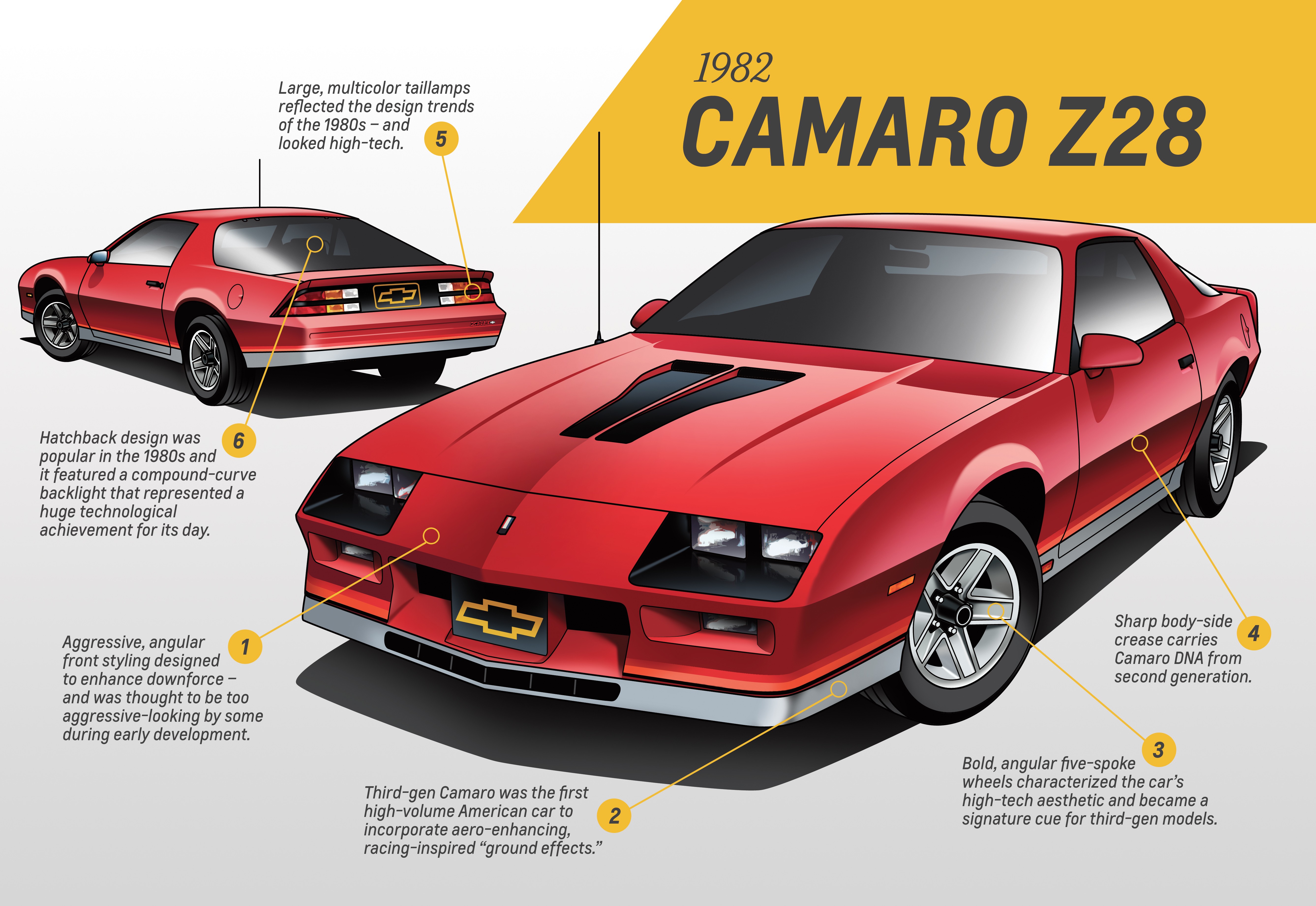
Camaro – Third Generation – 1982-92 – Design analysis: John Cafaro, executive director, Chevrolet Global Car Design
‘The third-generation Camaro represented a distinct breakaway from the previous generations, which were undeniably influenced by European grand touring cars. - John Cafaro, Chevrolet Global Car Design executive director
‘This was a uniquely American design with a form developed for function – and its aggressive front-end styling was deemed almost too aggressive by some in the company’, adds the designer, who previously owned a third-generation Camaro ‘1LE’ racecar’
The aggressive front end was designed to enhance downforce, as the third-generation Camaro was the first high-volume American car to incorporate aero-enhancing, racing-inspired ground effects. And for the first time, the Camaro was offered as a hatchback, with its large backlight being a technological achievement for automotive glass production because of its size and compound-curve sculpture.
The fourth Camaro
À la suite de problèmes de qualité survenus au début et dans les dernières années de production, ajouté à la grève des employés, GM a décide de déménager la production de la quatrième génération au Québec.
La 1990s Camaro est construite à Boisbriand au Canada. Le 4 cylindres étant abandonné, le moteur de base est un 6 cylindres de 3,4 L développant 162 ch, puis un V6 3,8 L de 200 ch. Les versions les plus musclées sont la Z28 et la SS qui ont droit au moteur 5,7 litres LT1, avec la boîte automatique ou manuelle T56 à six rapports. La Z28 développe 288 ch et la SS 310 ch à 330 ch.
En 1998 la Camaro a droit à quelques modifications au niveau des phares et un remodelage complet de l’avant ainsi que l’intérieur. Le « désuet » LT1 de fonte fait place à un nouveau moteur en aluminium, le LS1, qui équipait déjà la Corvette, celui-ci offre des possibilités de modifications beaucoup plus intéressantes que son prédécesseur. La Camaro Z28 développe alors 310 ch et en 2000, grâce à un remplacement du collecteur d’admission pour celui du moteur LS6, elle verra sa puissance portée à 330 ch. La Camaro SS touchera les 330 ch, puis 340 ch en 2000 jusqu’à son arrêt de production.
Avec son 0-100 km/h en 5,3 secondes, la Camaro (avec sa cousine Pontiac Trans-Am) est de loin la voiture américaine la plus performante (moteur à aspiration naturelle) du moment.
The design of 1993-2002 Camaro
With the fourth-generation model, Chevrolet went for an evolutionary design. Chevrolet Camaro exterior design manager Kirk Bennion, who owns a 1993 Camaro Z28, says the fourth-gen still looks aggressive today.
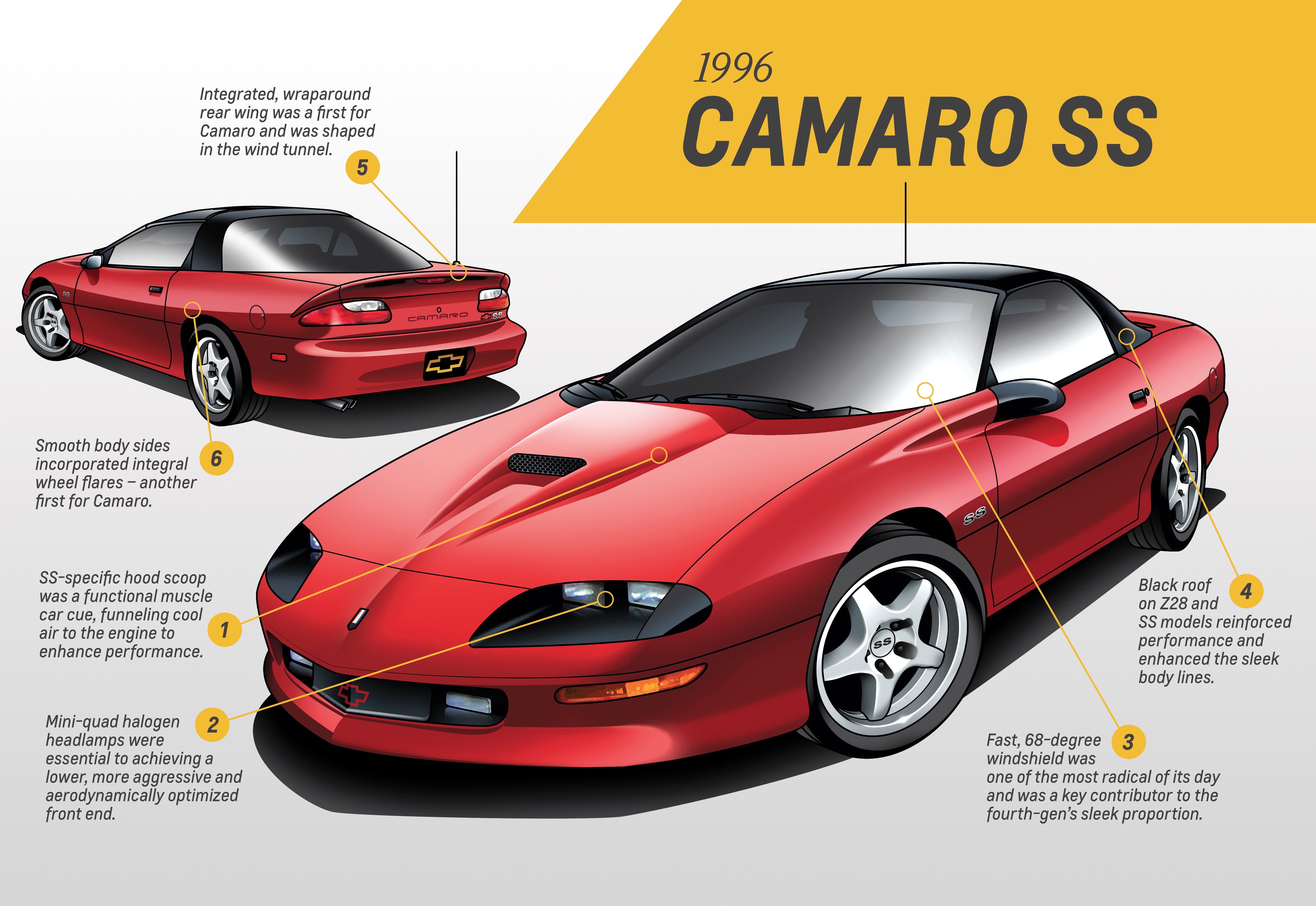
Camaro – Fourth Generation – 1993-2002 – Design analysis: Kirk Bennion, Chevrolet Camaro exterior design manager
‘More than 20 years after its debut, the fourth-generation Camaro still looks as sleek as anything on showroom floors today. It was a very aggressive design intended to evolve the proportion from the third-generation car with a provocative exterior and greater aerodynamic performance. It has a very sculptural form vocabulary that was definitely all-new for the Camaro,’
‘Having a low front end was important to the design. It really worked with the high deck lid rear spoiler to enhance the appearance of motion. All these years later, it still looks contemporary – and fast!’
- Kirk Bennion, Chevrolet Camaro exterior design manager
The most striking features are the fast-rake windshield, combined with a change to a “bottom-breathing” engine-cooling arrangement, to support the strong wedge shape of the overall car.
The fifth Camaro
5th Gen Camaro: 500,000 Performance Cars Sold in the U.S.
March 2015: Chevrolet is set to deliver its 500,000th fifth-generation Camaro, America’s best-selling performance car for five years in a row, in the United States this month. Now that’s what we call ‘power in numbers.’
Chevrolet a décidé de raviver la flamme de la Camaro en 2006 en présentant la Chevrolet Camaro Concept, qui a fait son apparition officielle en 2009. Esthétiquement, elle renvoie explicitement à la première génération (démarche similaire à celle de Ford pour sa Mustang).
Présenté sur la plate-forme Zeta et équipé du moteur LS3 V8 de 6,2 litres de 426 HP (transmission manuelle à six rapports) ou équipée du moteur LS99 de 6,2 litres de 400 HP (transmission automatique à six rapports), ou en version V6 de 3,6 litres développant 304 ch puis 323 ch à partir de 2012.
2010 Chevy Camaro Gets 29mpg on Highway
The V-6 version of the 2010 Chevy Camaro has 304 horsepower, but still gets 29 miles to the gallon the highway. How is this possible? Al Oppenheiser, Vehicle Chief Engineer for Camaro, explains how direct-injection technology and other tools help the car reach this level of fuel economy.
La camaro de cinquième génération se retrouve en six versions: LS, 1LT, 2LT, 1SS, 2SS et ZL1. Les versions LS & LT sont équipées de série du moteur de 3,6 litres tandis que le moteur de 6,2 litres est réservé au modèle SS.
The design of 2010-2015 Camaro
The soon-to-be-replaced Camaro launched after eight years of absence for the Camaro nameplate, which explains the huge enthusiasm that followed its launch.
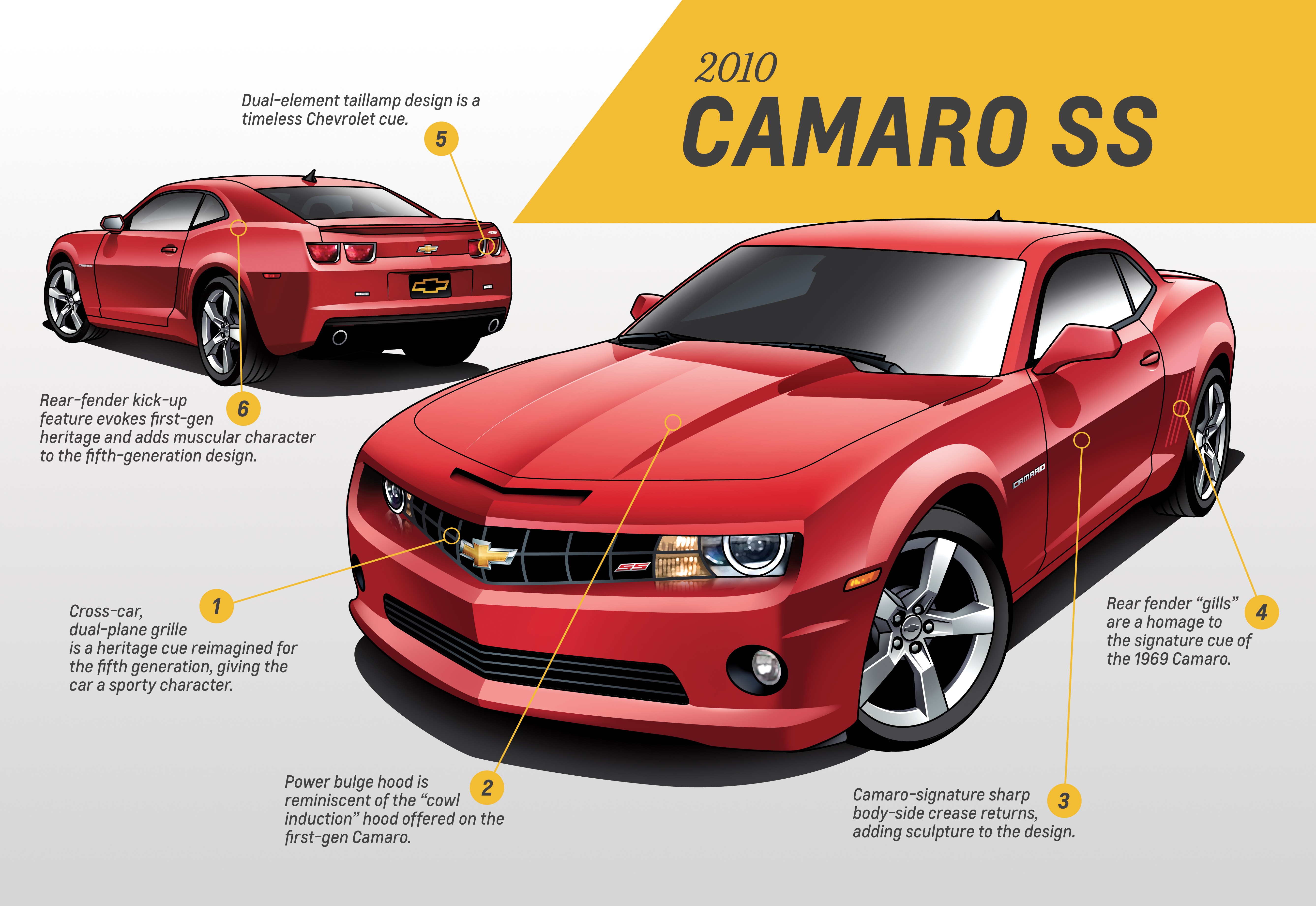
Camaro – Fifth Generation – 2010-2015 – Design analysis: Tom Peters, Chevrolet Camaro exterior design director
Chevrolet Camaro exterior design director Tom Peters, who owns a 1969 Camaro, says the fifth-gen model used the first generation model for inspiration, but it is more than just a 21st century update.
‘Distilling the timeless essence of the design and translating into a fresh, contemporary Camaro was a challenge. The final design perfectly straddled that razor-sharp line between heritage and retro – and with five straight years at the top of the segment, clearly the fifth-generation Camaro connected with a whole new group of enthusiasts.’ - Tom Peters, Chevrolet Camaro exterior design director
Pour la petite histoire, la Chevrolet Camaro Concept incarne le robot Autobots dénommé Bumblebee dans les films Transformers.
Transformers: Behind the Scenes – Working with GM – Chevrolet
Hear from the Transformers team about working with General Motors for Transformers: Age of Extinction, and take a look at some exclusive behind-the-scenes footage.
Chevrolet a présenté au Chicago Auto Show de 2011 la future version ZL1 de sa Camaro, reprenant le nom de code « ZL1″ en hommage à 1969.
La nouvelle version propose 580 ch. Avec cette version ultime, Chevrolet veut concurrencer la Shelby GT500 de Ford. Pour cette nouvelle version, le V8 LS3 de la SS fait place au V8 LSA, le même que sur la Cadillac CTS-V.
On dit aussi très souvent que c’est le même moteur que celui de la Corvette ZR1, à tort car sur cette dernière le V8 est un LS9 qui développe 647 ch. Le moteur LSA est en fait un dérivé du LS9 avec de nombreuses différences techniques. Entre autres : pistons différents, refroidissement de la suralimentation différent, et compresseurs volumétriques de capacités différentes (LS9 2,3 litres pour 0,72 bar maxi, LSA 1,9 litre pour 0,62 bar maxi). La ZL1 moderne se distingue par quatre sorties d’échappement, un kit de carrosserie plus agressif, et surtout le nouveau V8 LSA produisant 580 chevaux, cité plus haut, grâce à un compresseur Eaton, le couple passe donc à plus de 750 N.m. Ses suspensions sont des magnétique ride 3.0 et les freins sont fournis par Brembo, ils ont 6 pistons et des disques de 370 mm à l’avant et 4 pistons avec des disques de 365 mm à l’arrière.
Tout cela ont pour but de transformer la Camaro en véritable voiture de sport, et c’est chose réussie quand on voit son temps au Nordschleife de 7’41″27 (elle fait donc mieux que l’Audi R8 V10 5.2 et son 7’44″00 et que la Ferrari 599 GTB Fiorano avec 7’47″00).
2012 Camaro ZL1 Takes on Nurburgring – Chevrolet
Watch as the 580-horsepower Camaro ZL1 carves up Nurburgring in 7:41.27 – bringing the Camaro neck and neck with the Porsche 911 Turbo S and Lamborghini Murciélago lap times. The Camaro ZL1 used for the lap was a production-intent model, with no performance modifications, driven by Camaro Performance Engineer Aaron Link.
Chevrolet annonce la sortie de la nouvelle Chevrolet Camaro Z/28 2014 au New York International Auto Show 2013, mais Chevy a également dévoilé la Camaro SS 2014 avec un moteur V8 de 6,2 litres développant 437 ch.
2014 Camaro Z/28: The Legend Returns – Track Capable, Powerful, Aerodynamic – Chevrolet
There has never been a more track capable, factory built Camaro ever produced. The 2014 Camaro Z/28 is built according to any racer’s track car wishlist: lightweight, high-revving, aerodynamic and unrelenting in its handling. It removes the non-essential to make room for faster lap times and more thrills. What new roads will you find in the 2014 Camaro Z/28?
2016 Camaro
So what will the 2016 Camaro bring? All we know so far is that it “will be a truly all-new car, from the grille’s bowtie to the rear spoiler.” GM says the only two parts carried over from the current model are the bowtie emblem on the taillight panel and the SS badge for the V8 model. Sounds interesting, so make sure you mark May 16 in your calendars.
La nouvelle Chevrolet Camaro arrive le 16 mai 2015. Chevrolet en profite pour débuter le traditionnel teasing, avant la présentation finale à Park Belle Isle à Détroit. Chevrolet a publié différentes images de la nouvelle Camaro, aussi bien des éléments de carrosserie que le moteur ou le châssis.
The design of 2016 Camaro
The sixth-generation Chevrolet Camaro is expected to arrive as a 2016 model year vehicle in 2015. The vehicle will be all-new (completely reengineered and redesigned) and will be smaller and lighter than the fifth-generation model — improving the driving experience, performance, and fuel economy.
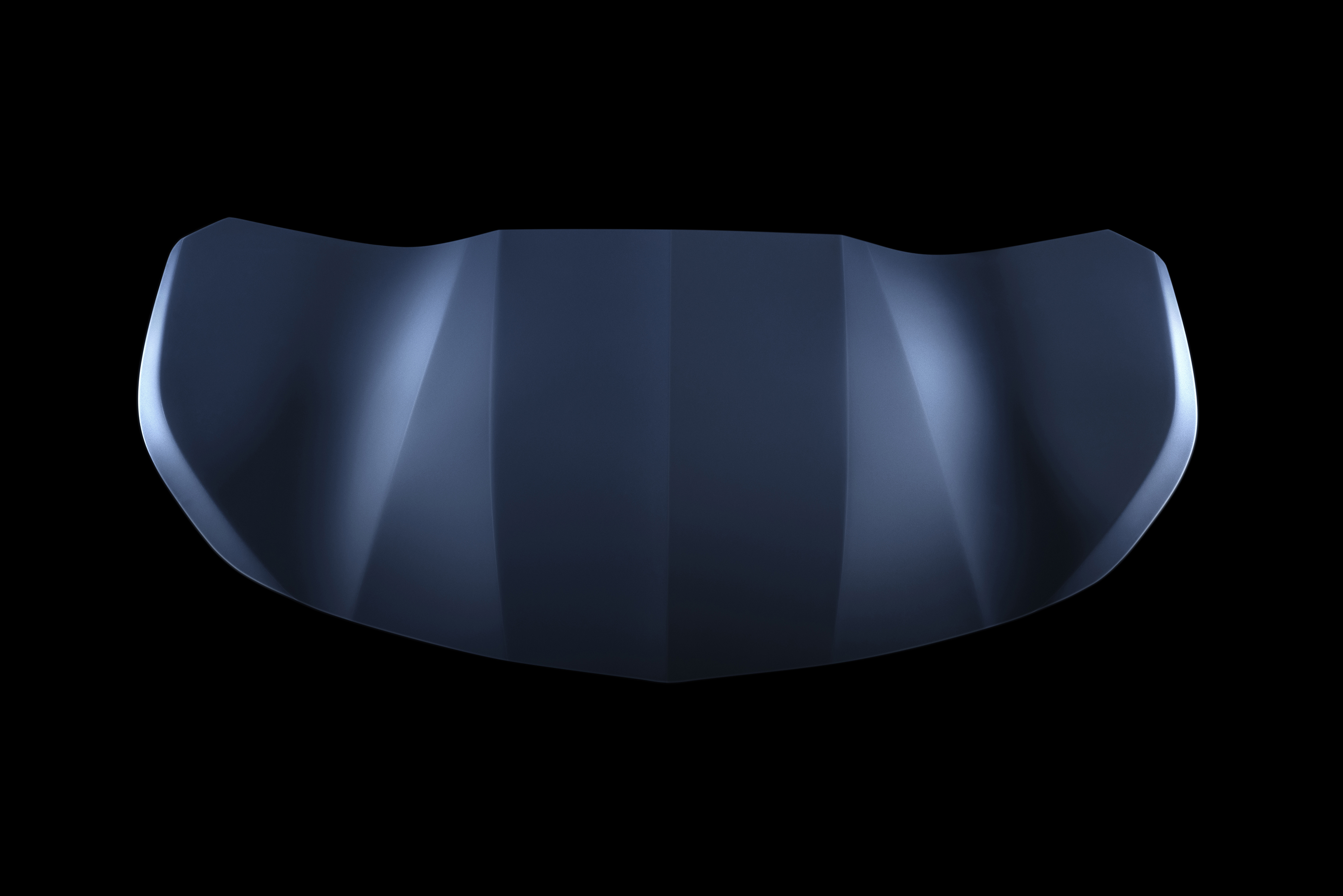
2016 Chevrolet Camaro – hood / capot (teaser)
Aerodynamic
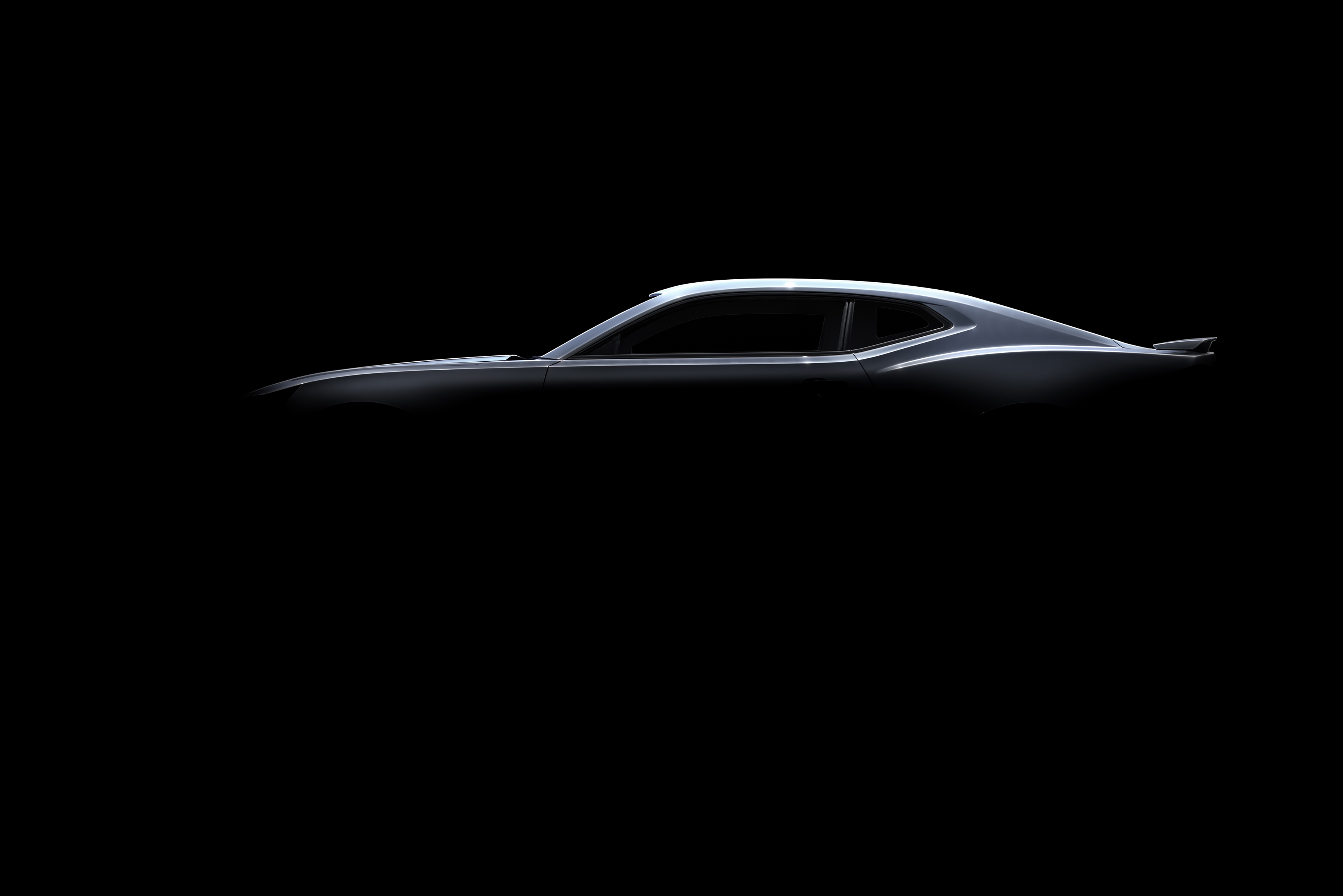
2016 Chevrolet Camaro – teaser
After 350 hours of wind tunnel testing – often 24 hours a day – the new Camaro will slip more easily through the wind, and drivers of the Camaro SS will experience a marked improvement in reduced aerodynamic lift.
These changes illustrate the lengths the aerodynamics team went to for improved performance, stability, cooling and lower wind noise intrusion
‘The importance of aerodynamics increases exponentially as we increase vehicle performance. As engine output increases, we need more engine cooling. As acceleration and top speeds climb, we need to reduce lift for better high-speed stability. However, we cannot make any changes at the expense of increasing drag, which can hurt fuel economy. To balance these different aerodynamic targets, we tested literally hundreds of changes on the new Camaro, millimeters at a time.’ – Kirk Bennion, Exterior Design manager, Chevrolet
For example, the initial design called for the lower grille bars to be set at a 20-degree angle to the horizon. However, after meticulous testing, the team improved engine-cooling airflow by 1 percent by shifting the angle to 13 degrees – a change that achieved the airflow target while maintaining the original grille design.
And rather than a traditional front air dam to reduce aerodynamic lift, the team developed a flush belly pan that stretches from the front grille to the center of the vehicle. Paired with small “spats” forward of the front tires, the smooth underbody helps reduce total lift by 30 percent – while also reducing aerodynamic drag.
Alpha architecture
The Gen 6 Camaro is based on General Motors’ award-winning Alpha architecture. Designed to compete with premium European brands, Alpha offers exceptional driving dynamics and refinement, as well as a balance of mass and stiffness necessary for a world-class performance car.
‘Our global engineering team is incredibly passionate about Camaro, and they sweated all the details to make Gen 6 the best Camaro we could possibly put into the hands of our customers. Alpha provided a strong foundation, but more than 70 percent of the components are unique to the Gen 6 Camaro, including exterior and interior dimensions, an all-new interior, front and rear suspension, and powertrain components. The minute you see – and hear – the Gen 6, you know it’s a Camaro, from the stance to the driving experience to the sound of the Small Block V-8.’ - Mark Reuss, GM executive vice president, Global Product Development
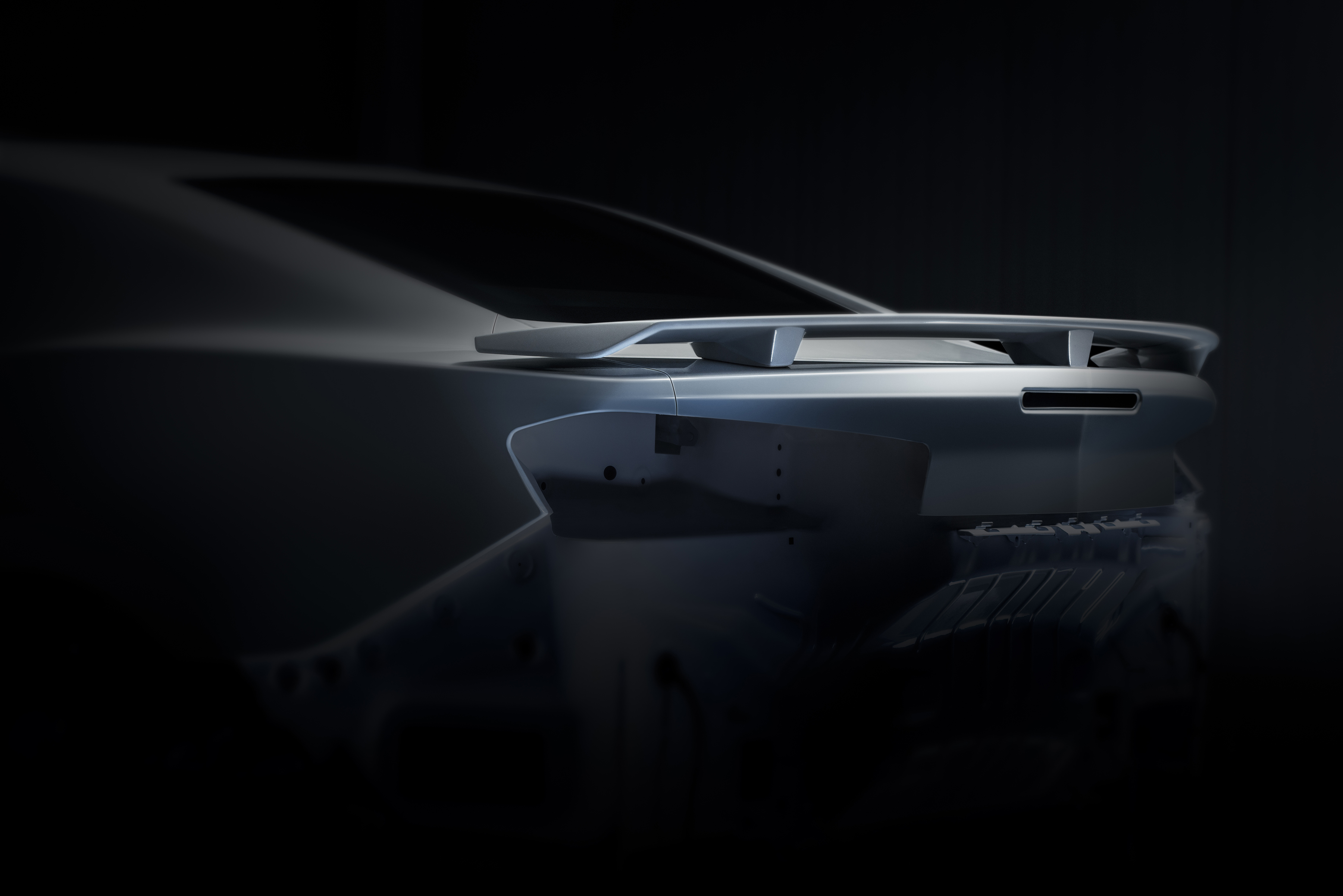
2016 Chevrolet Camaro – rear / arrière (teaser)
From the strong Alpha foundation, the Camaro team made the most of every component to create a worthy successor for the Gen 5 Camaro, which has been America’s best-selling performance car for five consecutive years.
The front structure, for example, was developed specifically for Camaro. It is lengthened, to create the dash-to-axle ratio necessary for car’s iconic profile, and widened to provide the desired track width for stable, confident cornering. In addition, 20 percent of the 6.2L LT1 V-8 engine has been tailored to fit the Camaro’s packaging, including new, tubular ‘tri-Y’-style exhaust manifolds.
The 2016 Camaro will use a variant of GM’s new rear-wheel-drive vehicle architecture known as Alpha. The platform, shared with the 2013 ATS and 2014 CTS from Cadillac, is expected to help reduce the weight of the new Camaro by anywhere from 150-300 pounds.
The sixth-gen Camaro is expected to jettison the classic-inspired design of the fifth-generation model and adopt an all-new design that’s modern and contemporary. The styling may have been previewed by the Chevrolet CODE 130R Concept originally unveiled at the 2012 North American International Auto Show.
While not much is known about the interior of the 2016 Camaro, the cabin of Chevy’s new affordable sports car is expected to be redesigned for better ergonomics, more high-technology, and an improved driver position while utilizing better materials throughout.
General Motors has confirmed that the next-generation Camaro will be produced at its Lansing Grand River assembly plant in Lansing, Michigan, alongside the Cadillac ATS and 2014 CTS. By contrast, the 5th-gen 2010-2014 Camaro was produced at GM’s Oshawa assembly plant in Canada.
The engine of 2016 Camaro
The 6.2L LT1 V-8 engine has been tailored to fit the Camaro’s packaging, including new, tubular ‘tri-Y’-style exhaust manifolds.
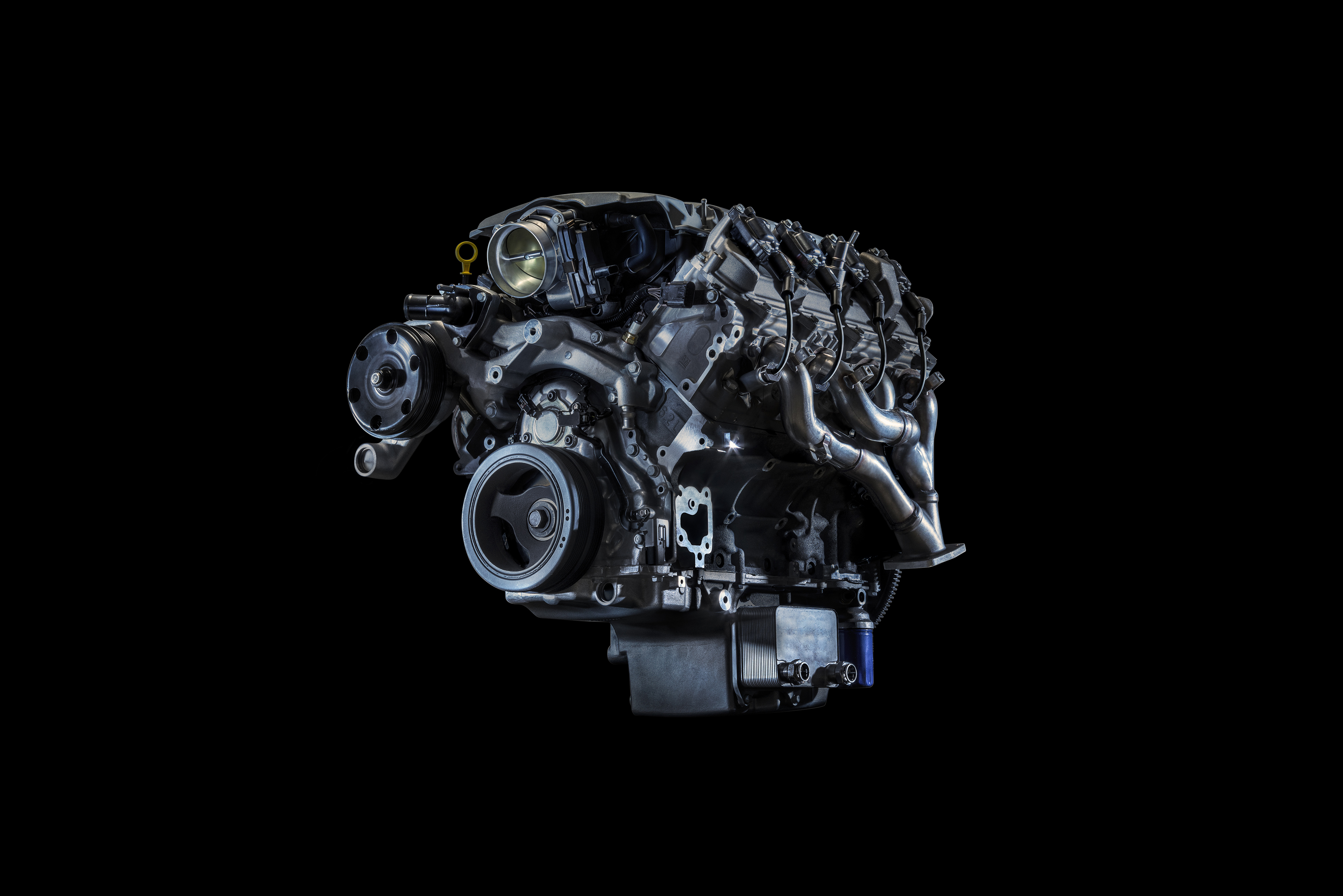
2016 Chevrolet Camaro – engine / moteur
Chevrolet Performance is proud to offer the all-new LT1 crate engine. Introduced on the seventh-generation Corvette Stingray, the LT1 6.2L opened the next chapter in the long, historic legacy of the small-block engine — and it gives your project vehicle a high-tech transplant with an outstanding balance of performance and efficiency. Our LT1 crate engine is rated at 460 horsepower and 465 lb-ft of torque. The LT1 is architecturally similar to the LS family of small-block engines, but with a unique block casting, cylinder head design, oiling system, and more. It also combines advanced technologies including Direct Injection and continuously Variable Valve Timing to support an advanced combustion system. - Chevrolet
6.2L LT1 V-8 engine, donc c’est le LT1, donc je vous invite à voir l’article Corvette C7 : entre design ré-imaginé et moteur traditionnel et en particulir ce passage « Côté moteur donc, la Corvette hérite d’un nouveau Small Block de 6,2l LT1 atmosphérique. »
Ces visuels sont accompagnés de différentes annonces telles que le poids de l’auto qui gagne ainsi une bonne centaine de kilos de moins grâce à l’utilisation de 70% de pièces nouvelles par rapport à la génération actuelle, malgré une rigidité structurelle en hausse de 28 % ou encore grâce à son nouveau V8 allégé. Côté style, Chevrolet annonce qu’elle sera plus « athlétique » mais aussi plus « expressive ».
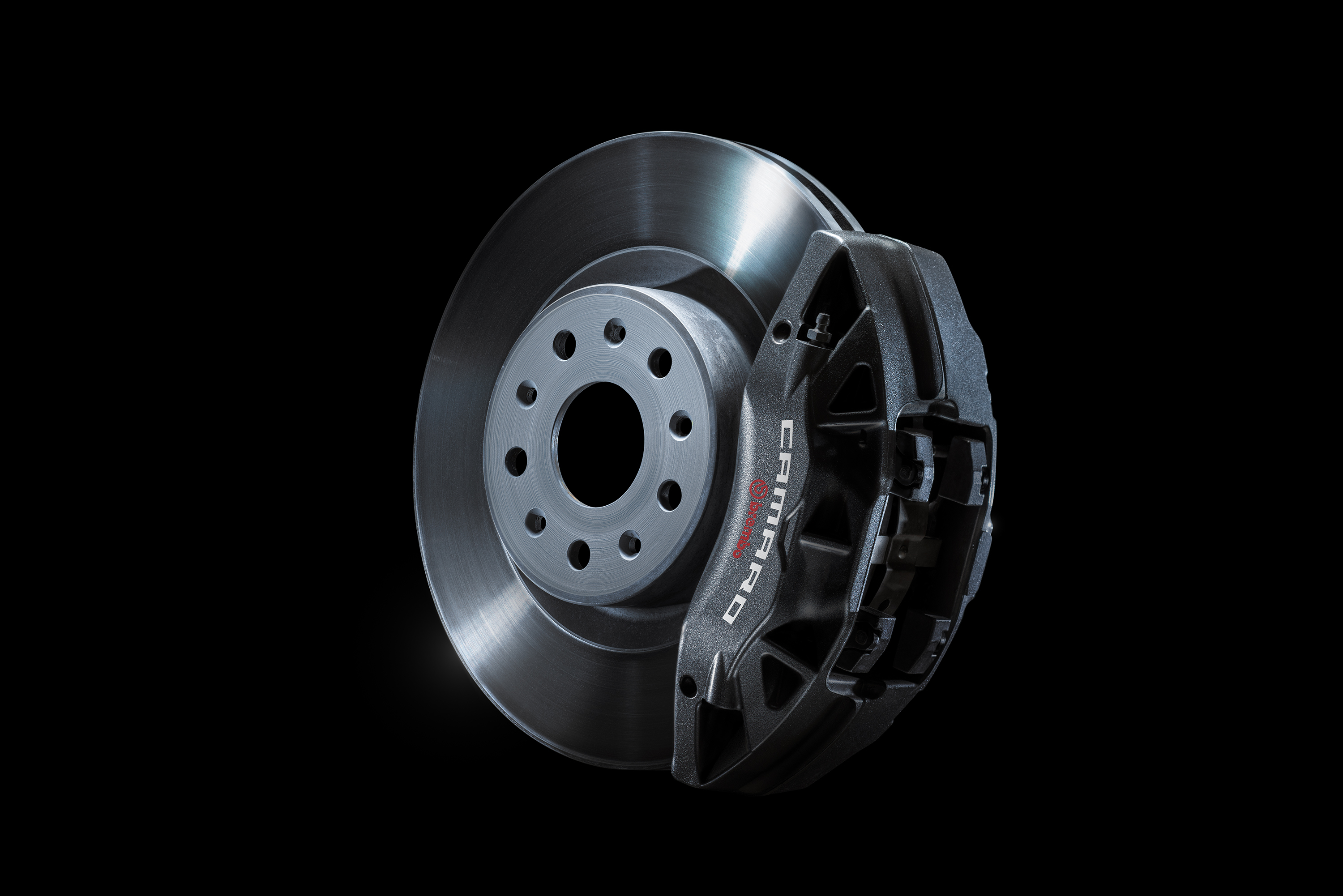
2016 Chevrolet Camaro – brakes / freins
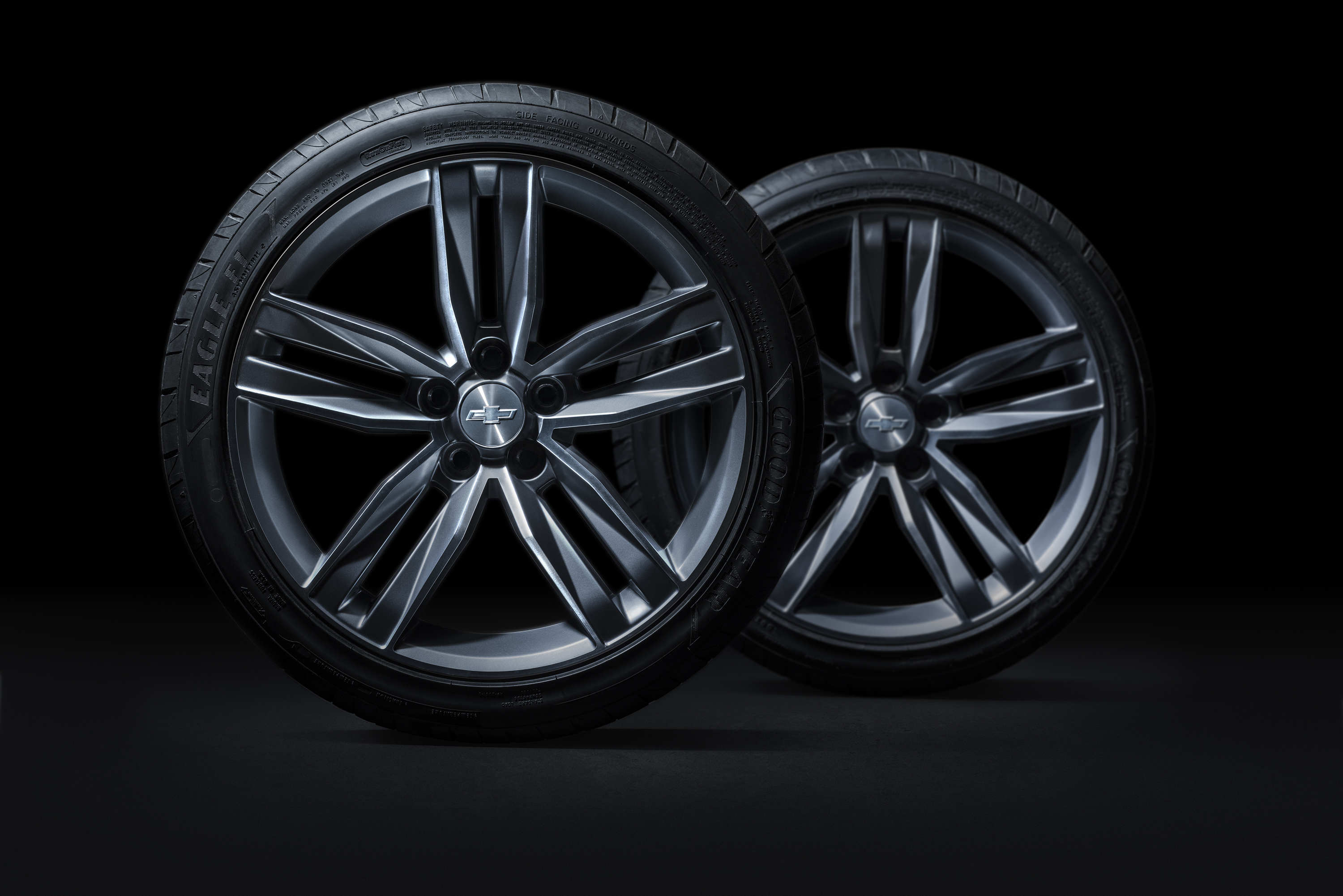
2016 Chevrolet Camaro – wheels / jantes (teaser)
Next Generation Camaro – The Silence is Broken – #CamaroSix Chevrolet
Every piece of the next generation Camaro will be refined in the name of performance from the inside out. The silence is broken.
Here the site dédié à l’event: thecamarosix.com
Plus qu’a attendre le 16 mai et les infos officielles de th Sixth Camaro provenant de Chevrolet.
MAJ 16/05/2015 : 22h20 (France)
2016 Camaro Reveal Recap from Belle Isle, Detroit
The wait is over, Camaro fans – the all-new #CamaroSix has been revealed. Passionate fans from all over, classic Camaro’s, and hot laps made this a reveal to remember. What do you think?
Le design de la 2016 Camaro
La sixième génération reste proche de la cinquième génération dans sa version récente. On retrouve à l’avant une fine calandre, prolongée par des optiques aiguisées. A l’arrière, on découvre des feux dessinés d’un bloc. Selon les versions, RS ou SS, il y a deux ou quatre sorties d’échappement.
Camaro’s leaner, stiffer platform and slightly smaller dimensions are accentuated by a dramatic, sculpted exterior. Meticulously tuned in the wind tunnel, the exterior contributes to performance through reduced aerodynamic lift for better handling while enhancing efficiency.
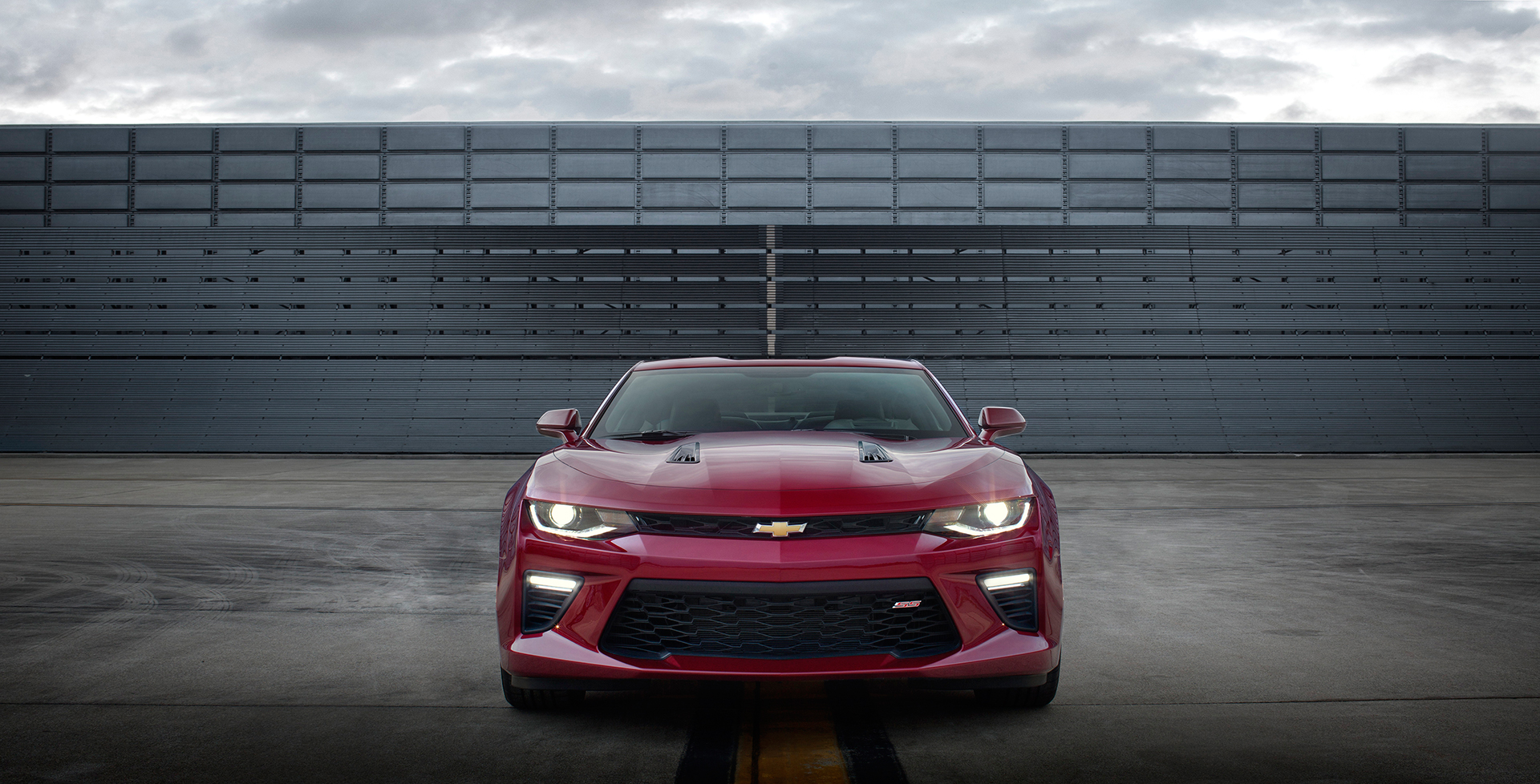
Chevrolet 2016 Camaro SS – avant / front
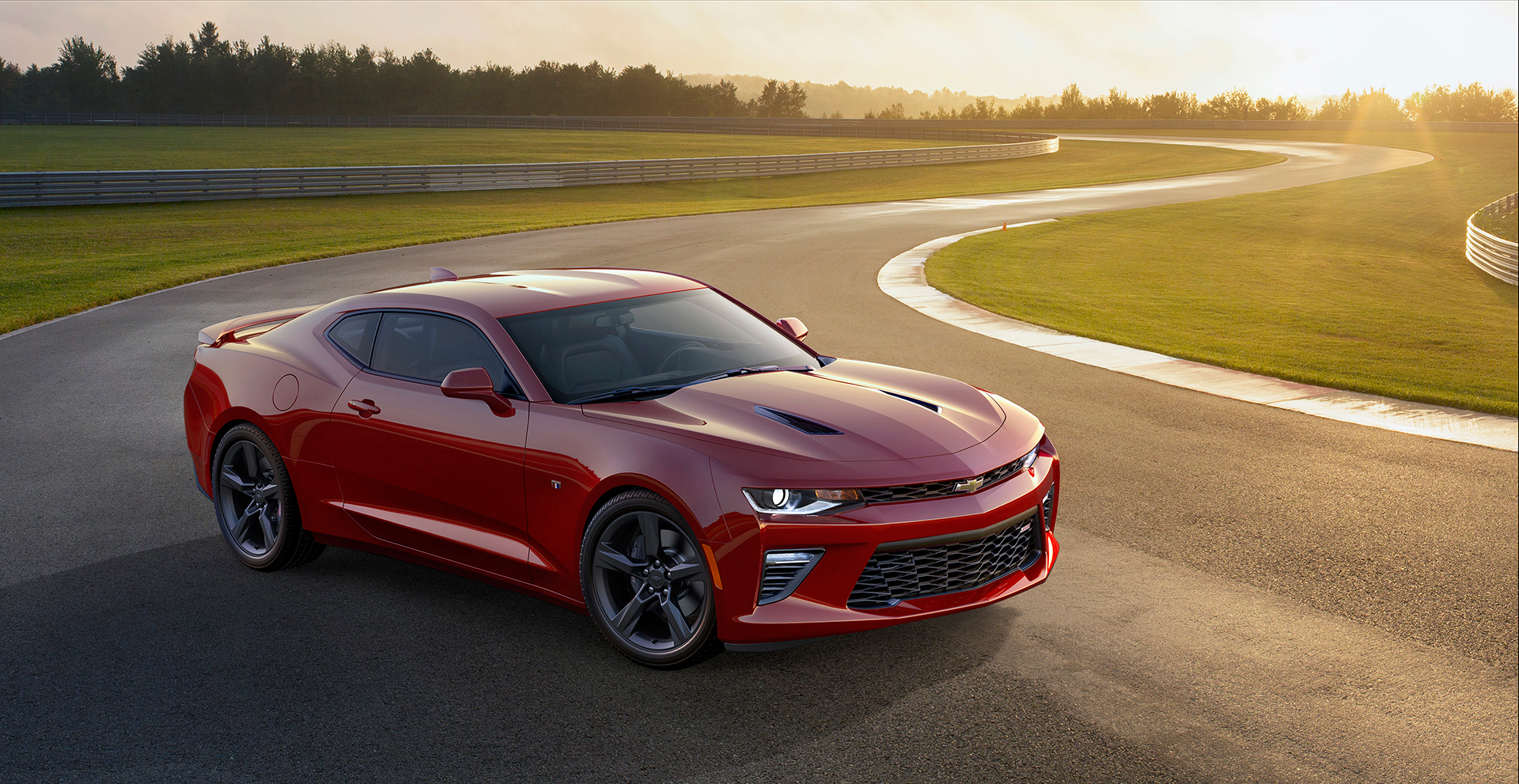
Chevrolet 2016 Camaro SS – profil / side-face
‘Redesigning the Camaro is thrilling and challenging all at once, but the secret is to offer something more. For Camaro enthusiasts, it retains iconic design cues and offers even more performance. For a new generation of buyers, the 2016 Camaro incorporates our most innovative engineering ideas with finely honed performance and leading design.’ - Mark Reuss, General Motors executive vice president of Product Development
Only two parts carry over from the fifth-generation Camaro to the new Gen Six: the rear bowtie emblem and the SS badge.
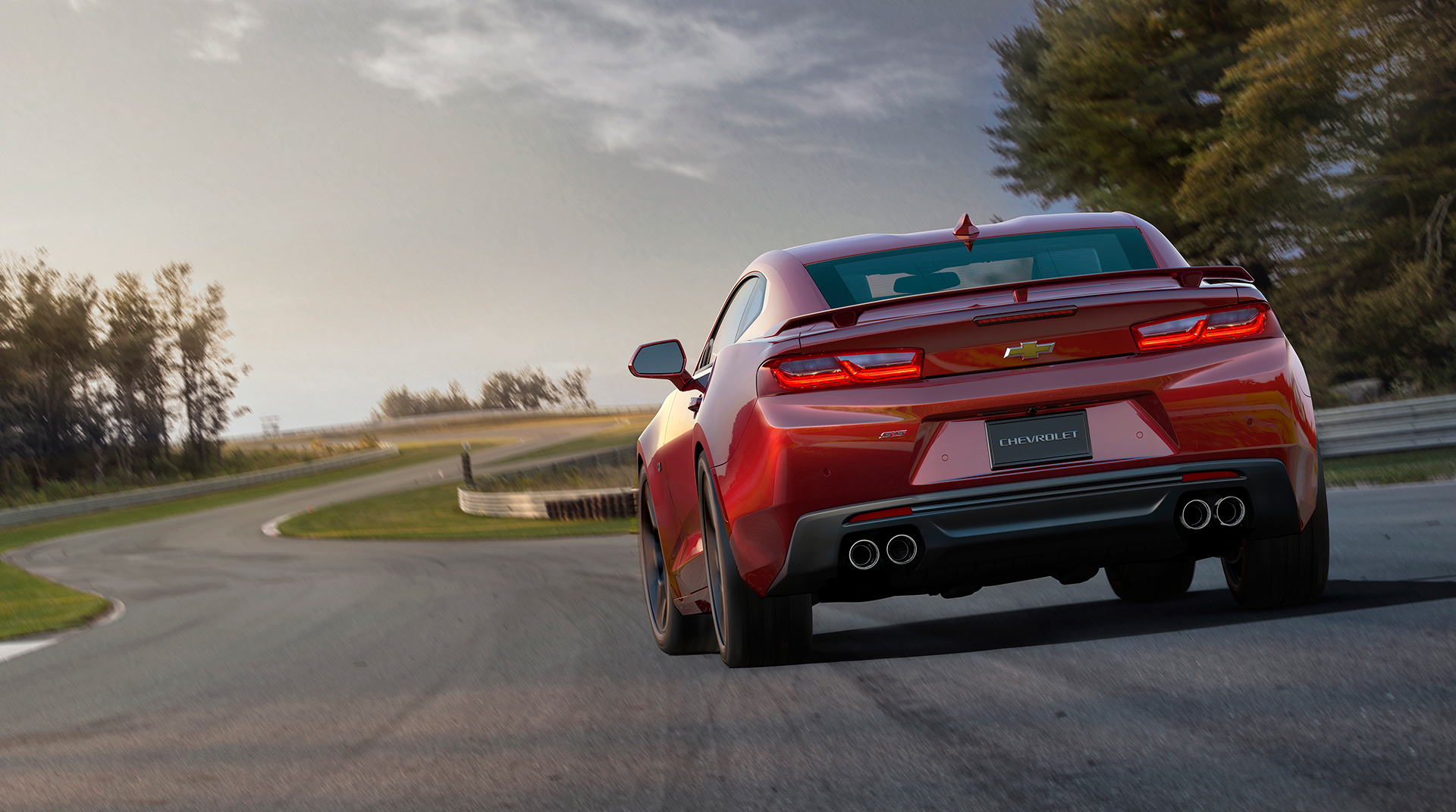
Chevrolet 2016 Camaro SS – arrière / rear
Le design intérieur de la 2016 Camaro
La planche de bord étonne par son originalité avec la présence des aérateurs centraux en bas de la console central. Sur le tableau de bord, entre deux compteurs à aiguille se trouve un écran couleur de 8 pouces.
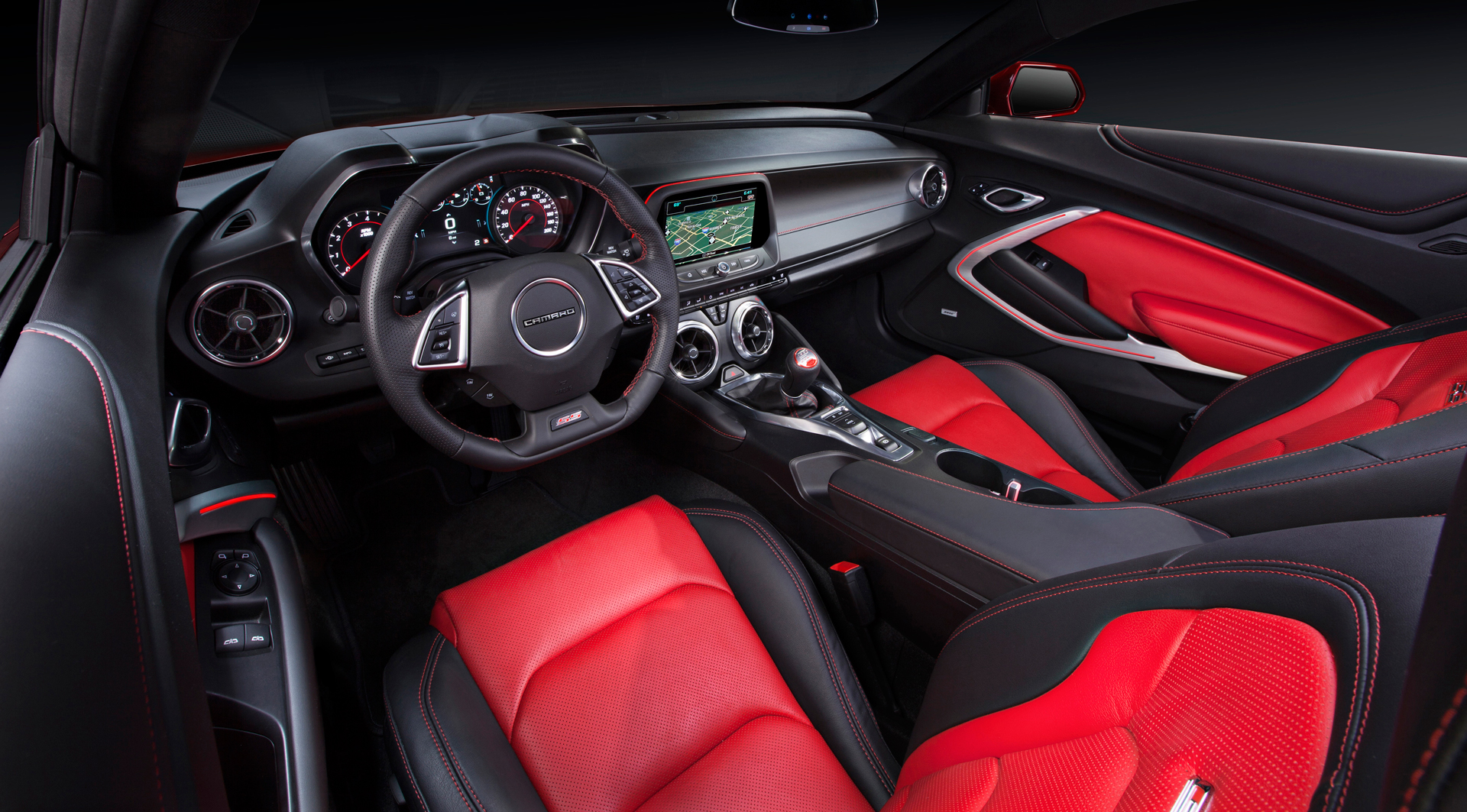
Chevrolet 2016 Camaro SS – intérieur / interior
A driver-focused interior integrates class-leading control technologies, including a new Driver Mode Selector, configurable instrument cluster and a customizable ambient lighting feature.
Le moteur de la 2016 Camaro
Sous le long capot de la Camaro 6. Comme la Mustang, la nouvelle Camaro adopte un bloc quatre cylindres. Il s’agit d’un 2.0 litres turbo qui développe 275 ch. Chevrolet propose ensuite un V6 atmosphérique 3.5 litres de 335 ch. La version SS trouve le V8 6.2 litres, de 455 ch. le Small Block 6.2L LT1 V-8 engine. Tous les moteurs sont associés d’origine à une boîte manuelle 6 rapports ou une automatique 8 vitesses avec palettes au volant.
The Small Block 6.2L LT1 V-8 engine
The 2016 Camaro SS is powered by the Small Block 6.2L LT1 V-8 engine, with output SAE-certified at 455 horsepower (339 kW) and 455 lb-ft of torque (617 Nm), making it the most powerful Camaro SS ever.
Its use in the sixth generation marks the third time the LT1 moniker has been bestowed on a Camaro Small Block V-8 engine, with previous iterations used in the 1970-72 Z28, 1993-97 Z28 and 1996-97 SS.
About 20 percent of the components are specific for the Camaro’s architecture, including new, tubular “tri-Y”-type exhaust manifolds. It also offers advanced technologies, such as continuously variable valve timing, direct injection and Active Fuel Management (on automatic-equipped models) to help balance efficiency and performance.
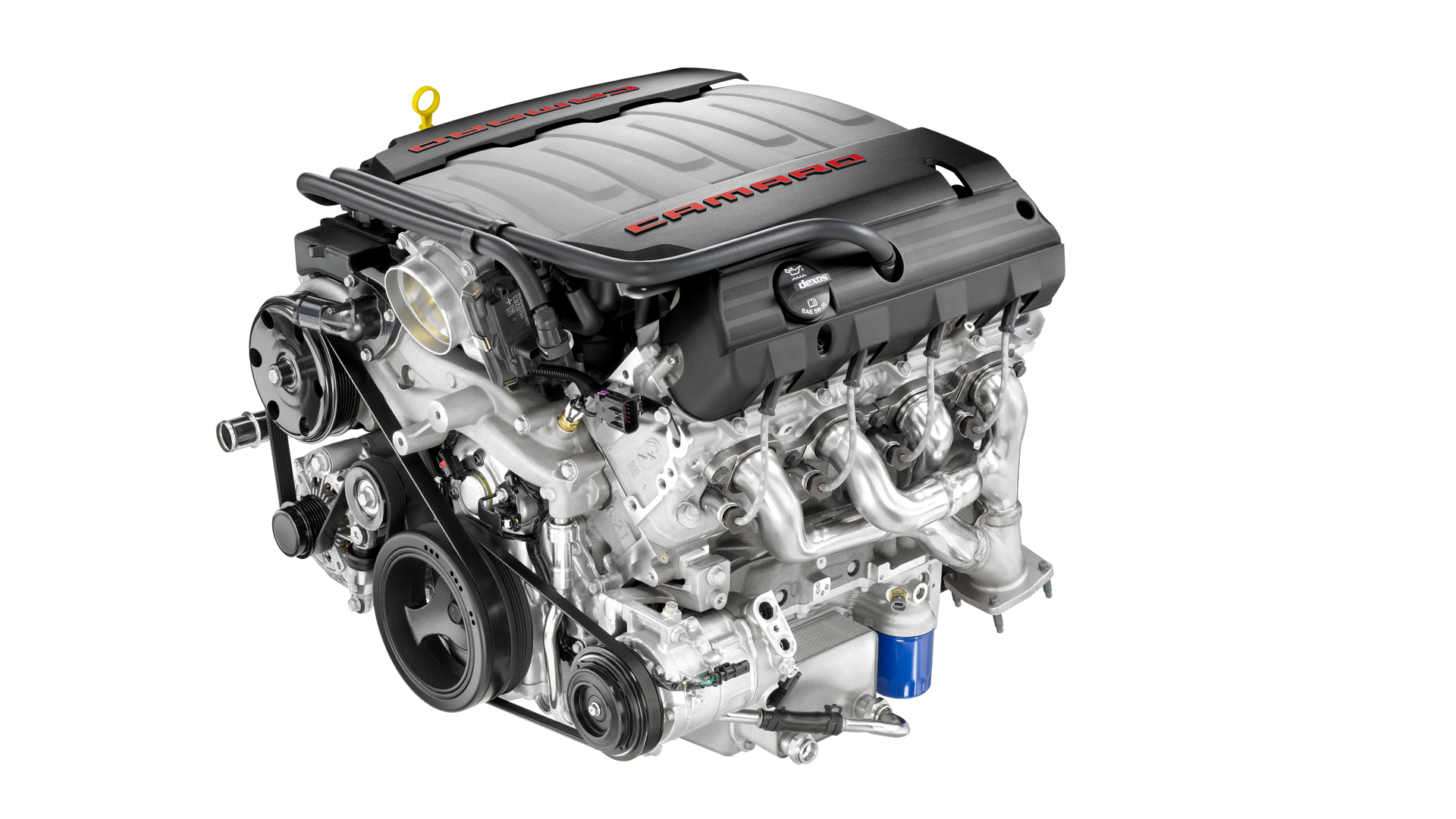
Chevrolet 2016 Camaro SS – moteur / engine
Those technologies support an advanced combustion system that incorporates a unique cylinder-head design and a new, sculpted piston design that is an integral contributor to the high-compression, mixture motion parameters enabled by direct injection.
Compared to the fifth-gen Camaro SS’s previous LS3 engine, the new LT1 cylinder head design features smaller combustion chambers designed to complement the volume of the unique topography of the pistons’ heads. The smaller chamber size and sculpted pistons produce an 11.5:1 compression ratio, while the head features large, straight and rectangular intake ports with a slight twist to enhance mixture motion. This is complemented by a reversal of the intake and exhaust valve positions, as compared to the previous engine design. Also, the spark plug angle and depth have been revised to protrude farther into the chamber, placing the electrode closer to the center of combustion to support optimal combustion.
The pistons feature unique sculpted topography that was optimized via extensive analysis to precisely direct the fuel spray for a more complete combustion. The contours of the piston heads are machined to ensure dimensional accuracy – essential for precise control of mixture motion and the compression ratio.
Source et images :
GM, Chevrolet
… et synthèse des pages Wikipedia :
Chevrolet Camaro
Big block
… et source English text via
GM Authority, 2016 Camaro
… et source English text and infographic
via media.gm.com A Generational Thing: Camaro Design through the Years, Chevrolet designers reflect on five generations of iconic style.
Partager la publication "Chevrolet présente la Camaro on Saturday, May 16 à Detroit #CAMAROSIX MAJ 16/05 : 23h"

